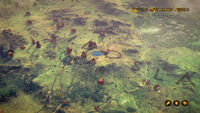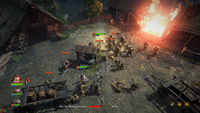|
|

|
PLATFORM
|
PS4
|
BATTLE SYSTEM
|

|
INTERACTION
|

|
ORIGINALITY
|

|
STORY
|

|
MUSIC & SOUND
|

|
VISUALS
|

|
CHALLENGE
|
Moderate
|
COMPLETION TIME
|
Less than 20 Hours
|
|
OVERALL

|
+ Successful adaptation of source material
+ Narration vividly paints immersive world
+ Strong soundtrack with epic choir tracks
- Clunky gameplay and technical issues
- Lack of meaty RPG gameplay elements
- Dull and frustrating combat
|
Click here for scoring definitions
|
|
|
The Dwarves is based on the series of novels by the same name. It boasts impeccable presentation, adeptly using its source material and complementing it with great narration, voice acting, cutscenes, and interactivity. This combination offers a unique and enjoyable experience that straddles the lines between RPG, movie, and novel, and delivers a satisfying fantasy adventure. However, the many technical glitches can be frustrating, and the dull combat and noticeable lack of meaty RPG gameplay elements will turn off players looking for a richer gameplay-focused experience.
The Dwarves stars Tungdil "Goldhand" Bolofar, an orphaned dwarf blacksmith who was raised by and lives among humans and has never met other dwarves. The story is set in Girdlegard, a protected land divided into five magical realms and several different kingdoms. During the opening events, Tungdil is tasked with a simple errand to return magical artifacts to his foster father's former famulus (student) who resides in a far-away city. Although the task is mundane, Tungdil is especially excited by the opportunity to venture out and explore, and at the prospect of potentially meeting other dwarves. Not long after venturing out, Tungdil encounters both friends and foes and his mundane task quickly turns into the beginnings of a much grander quest to protect Girdlegard.
The story in The Dwarves covers the first book in the series, focusing on saving Girdlegard from the Alfar, the horde of Orcs they've recruited to do their bidding, and the spread of the Perished Land. While it is a fairly standard high-fantasy story and quest, the source material is well written and the adaptation is competent. This leads to a fairly conventional plot but nevertheless enjoyable and epic adventure. The characters are fun and interesting, featuring engaging dialogue and interactions and good voice acting. The world is unique and deeply developed, with its own rules and history. The narration is excellent in both content and delivery, and paints a more expressive and immersive picture of the characters and locations of the world than cutscenes and graphical assets. The overall presentation successfully meshes the cinematic quality of movies and interactivity of video games while stimulating players' imaginations in a way reminiscent of reading a good book. The sum of these parts is surprisingly effective, making The Dwarves worthwhile to experience.
Upon exiting the first area players are placed on the world map, a network of nodes representing locations and the various paths connecting each node to the others. Any nodes connected to the currently occupied node can be selected with a cursor and visited. Some locations can be entered while others are only described — though generally in great and intricate detail — by the narrator. Tungdil is also faced with a number of choices when visiting different areas, which may relate to a quest or simply help to define Tungdil's character. Although choices don't change the outcome of the main story, they help shape the reasons these outcomes come about, thereby leaving a significant mark on the narrative. For example, at a certain point in the story, no matter which choices are made, one of the characters will leave the party. But the reasons that lead the character to leave are vastly different, meaningfully impacting the characters' motivations even though the outcome remains unchanged.
Graphics in The Dwarves are attractive, detailed, and vivid. There are few explorable areas and each area is small in size. Most of the game instead takes place on the aforementioned world map or in battlefields. The environments that do exist span many settings, including nature scenes, towns and cities, and dwarvern fortresses, all of which feature unique, aesthetically appealing graphical designs. Character designs are suited to the world with just the right amount of diversity and without being overly flashy or overdesigned.
 This world map may seem bland, but it will be teaming with life after hearing the narrator describe each location.
This world map may seem bland, but it will be teaming with life after hearing the narrator describe each location.
|
|
The Dwarves features a strong soundtrack with tracks that adeptly capture and enhance the high-fantasy, dwarf-focused setting. The tracks cover a wide range, from slow and somber, to calm and bright, to epic choir and battle tracks, with an appropriate focus on the latter. There is even a silly-yet-epic song with in-character lyrics during the credits. Although the soundtrack is on the short side with only twenty or so tracks, the tracks are consistently good and the type that fans can enjoy even outside of the game.
While story and presentation are successfully executed, combat is unfortunately a bit of a mess. Any four of a number of different characters can be selected to participate in each battle, with Tungdil being a required character most of the time. The battle system features real-time-with-pause but unlike other similar games it rejects RTS-type controls in favor of a different control scheme. Only one of four characters can be selected at any one time, and the selected character can be moved around the battlefield using the analogue stick. Characters can also use their abilities if they have enough action points, which slowly regenerate over time or when characters score kills. The key interesting mechanic of the battle system is that it includes physics simulations. Characters can block each other's movements and can push each other around. Although the four ally characters are typically massively outnumbered by hordes of weaker enemies, using these abilities cleverly to knock enemies down cliffs and into environmental hazards can turn the tides of battle.
Although these ideas look good on paper, limited, unimaginative abilities and technical issues make for an overall unsatisfying experience. Aside from auto-attacks each character only has three abilities to use. Furthermore, there is quite a bit of overlap between ability effects as well as between which abilities characters learn. Most abilities simply do damage, push enemies, or a combination of the two. There are no reliable crowd control abilities, few short-duration status effects, limited healing, and generally little synergy between different abilities to keep combat interesting. Unlike on the PC version where auto-attack targets can be selected, on the PS4 auto-attack targets are determined by proximity, making focused attacking all but impossible in a game that pits players against hordes of enemies who can physically push the characters. Moving characters is also difficult due to a combination of frequent lag spikes, clunky controls, and physical blocking by ally characters who cannot easily be moved out of the way. The stiff controls often lead to unnecessarily taking friendly fire from some abilities. AI of enemy combatants is also glitchy and leads to most enemies standing idle with only a handful engaging in combat at a time. When the enemy AI is working correctly, lack of aggro control and crowd control in combination with aggressive ally AI often leads all of the enemy combatants to target a single weaker character, and the limited healing makes it difficult to keep that character alive. Due to all of these issues it is often easier to use only a single combatant to fight while keeping the remaining three combatants out of battle.
 You probably wanted to be attacking a different target, didn't you? Such are the careless whims of the game's targeting system.
You probably wanted to be attacking a different target, didn't you? Such are the careless whims of the game's targeting system.
|
|
In addition to the poorly implemented and glitchy combat system, The Dwarves suffers from a variety of technical issues outside of combat. The game crashes frequently, often after hard battles while attempting to load the follow-up cutscenes, forcing players to repeat those battles. It also suffers from frequent and long load times, frame rate dips and stuttering, and screen tearing. It is even possible to fall beneath the world in certain areas. These issues can range from mildly annoying to outright frustrating when difficult and time consuming battles need to be repeated. The Dwarves is also lacking in many RPG elements and progression. While characters can level up, there is no customization of statistics available, or even visible statistics in general beyond hitpoints. The full extent of customization is that every few levels one of two available abilities can be learned. This lack of customization extends to equipment, which is to say that there are no weapons or armor to be found. There is only a single slot per character into which talismans with various offensive and defensive effects can be equipped.
The Dwarves features a deeply developed world, enjoyable characters, and the first of a multi-part story that although straightforward is nevertheless interesting and well-presented. The few in-game environments that exist are detailed and vivid, and the excellent narration paints the rest of the world just as vividly in players' imaginations. The soundtrack focuses on epic battle and choir music but is also varied enough to sufficiently cover all other moods and situations and can be enjoyed even outside of the game. Despite these positive aspects The Dwarves is dragged down by its dull and frustrating combat, lack of RPG and character progression elements, and is mired by a host of technical issues. Players looking for a smooth gameplay experience, engaging battles, and meaningful character progression should pass on this one, but those willing to put up with the game's faults will be rewarded with an experience that combines the best elements of books, movies, and video games into an authentic, satisfying, high-fantasy adventure.
Review Archives
|









